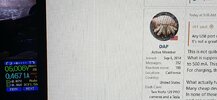Your phone has a proper USB port on it (you can transfer data over that port), so it requested the 500 mA, was granted permission from the device and started drawing 500 mA. This is not at all surprising, and behaving exactly as the specification requires.
The condition where a port would deny the request for 500 mA is usually an un-powered hub where the hub is drawing all of its power from a single up stream USB port, and providing two or more down stream ports. This can usually handle a mouse & keyboard and another device or two each drawing 100 mA or less, but would refuse any device that requested 500 mA.
Are you actually reading these posts?
I said...
Any USB port will charge a phone, even if at a slower rate
bold and italics for emphasis added now
To which you replied
and then...
This is true in an overwhelming majority of cases.
then...
Your phone has a proper USB port on it... This is not at all surprising
Refer above, where i said
a phone... did you miss that part?
You're being so argumentative you have no idea what you're talking about now, making twists and turns everywhere you can to make a point... and then still failing.
This all started with you misquoting me to suggest i said...
and now you come here telling us
that Viofo uses unsuitable / faulty or fake ICs in these converters as it is clearly a fail caused by the logic malfunction and a poor design choice!
It was a possibility and still is possible some of these IC's are fake, faulty or counterfeit.
But let's be clear, i never straight up made such a sure and plain accusation as you imply.
Simply put - this is a thing that did not happen -, that is the basis for everything you've said since.
Also in the same post you said
I will look at that thread to see how many people will report the same problem as you.
For the record this is a faulty way of ascertaining number of failed units, and you either know it or are stupid.
The vast majority of users with faults will not post here, they will go back to their point of sale, or use other forms.
This place only captures a small subset. Interestingly though, there are actually quite a few reports of failures anyway that are outside of this thread.
Viofo has also agreed in a DM that a batch fault is likley and has been replacing units no questions asked.
Also the fault found in the HK3 does not stop a lower current device from working (short term) so there are many faulty units that in a particular install appear to work, even though they are feeding 7+v into a camera and probably slowly killing it.
But by your logic everyone with a faulty HK3 has to test is and appear in only this thread to count, and you'll only count 1 per user.
What about my 3 failed units? Count that as one?
You've said enough and every reply you make discredits you more.
The facts remain...
1) There IS and issue
2) We have evidence of it
3) We have some theories as to causes
4) No one is making straight up accusations
5) Viofo is dealing with it in a good and honest way...
But ignore all you like, but you...
1) Seem to have an agenda
2) Misquote and mis represent facts
3) Redirect and obfscucate the discussion when you lose an argument
4) Provide no evidence
5) Contribute nothing that ads to the conversation
I'm not doing this any more, i'm done with your rubbish.
You are ignored from this point on.
Nothing will be achieved by continuing this, feel free to have the last word.. I won't see it.




